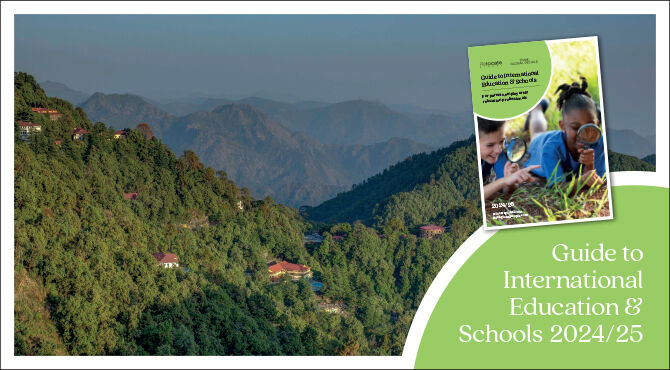Focus on India
International schools are looking to India’s growing prosperity and vast population and responding to strong demand. It’s a uniquely segmented market, but a clutch of high-profile British schools are set to join over 900 other international schools already there. Sally Robinson reports.
This article is taken from the Autumn 2024 issue of
Think Global People magazine
Click on the cover to access the digital edition.Where are the main expat destinations?
Expats are concentrated in the main cities of Delhi, Bengaluru, Mumbai and Kolkota. Delhi is the country’s capital and largest city in India, Mumbai is the financial capital, while Bengaluru is often called the ‘Silicon Valley’ of India and home to tech industries.Although expats love the cultural diversity and energy of living in India, it is not the easiest place to settle. The InterNations Expat Insider Survey for 2023 ranks India at 36 out of 53 destinations. It scores relatively poorly for quality of life: pollution levels, a lack of green spaces and ease of moving around are common complaints.The biggest groups of expats are from the US followed by the UK and the main employment sectors are tech, education and transport and logistics.How does the Indian education system work?
With a population of 1.4 billion people India has one of the largest education systems in the world. According to Education International, there are 1.5 million schools, 9.5 million teachers and more than 250 million students.Around 69% of schools are government run and there is a substantial private sector. At secondary level, over 50% of schools are private and Indian children are increasingly being sent to international schools. The most common Indian curriculum is the Central Board of Secondary Education, which conducts GCSE-equivalent exams at the end of Year 10.The government introduced sweeping education reforms in 2020 with its new National Education Policy (NEP). This makes school compulsory from 3–18 years, introducing three years of pre-schooling from ages 3–6. The reforms include a curriculum with less emphasis on rote learning and more on understanding and multidisciplinary learning.It’s unusual for expats to send their children to Indian schools, not least because learning takes place in the state’s local language with English introduced from grade 5. Most expats choose international schools for familiarity and continuity of curriculum.What is the current state of the international schools market?
According to ISC Research there are 900 international schools in India and there has been growth in both demand and supply over the last year. India now sits second only to China in the number of international schools.There are 416,000 students aged 3–18 enrolled in international schools in India and most are students from local families, rather than expats.Why the increase? A change in government policies, greater economic prosperity and the prioritising of education have all contributed.“The affordability is definitely there,” Freddie Cloke, head of school development at ISC Research, told the International Private Schools Education Forum (IPSEF) conference in June. “We are seeing massive economic growth, huge infrastructure development and a big rise in the middle classes, as well as more expats coming in.”The international schools market in India is more complex and segmented than in other countries. This is mainly due to India’s diverse socio-economic population. India has historically been seen to occupy a low- to mid-market price point when it comes to international schools. However, the last year has seen a flurry of openings and deal-signing with premium British schools.Harrow International Schools opened a boarding school on a 50-acre site in Bengaluru in 2023 for students aged 11–18 and, in September 2024, Wellington College International (in partnership with India’s Unison group) opened in Pune, a rapidly growing city in the state of Maharashtra with a thriving tech and start-up culture. Wellington College International has also signed a multi-school deal to open elsewhere in India. Millfield School is set to open in Mumbai in 2025 and Whitgift School is opening a co-branded school in Hyderabad in 2026 under the brand of SageBrook. Shrewsbury International will also open a boarding school for ages 11–18 in 2025 in Madhya Pradesh, its fifth international school and first in India.International education groups also have a presence in India. Nord Anglia operates five schools under its Oakridge International School brand, offering a blend of GCSE, IB and the Indian Central Board of Secondary Education (CBSE) curricula. Globeducate has six schools in India under The Indian Public School (TIPS) brand offering the IB and Indian CBSE.American and British schools are well represented and there are others offering curricula from Japanese to Russian, German and French, including the Lycée Français International in Mumbai and Delhi and the American Embassy School in Delhi.Read related articles
- International education: The Future
- New UK government sets intentions for international trade talks and growth
- Serviced apartments: can the sector’s global growth be sustained?
- Cambridge launches its first education programme for 3- to 6-year-olds
- AltoVita launch new Alto360 product at Smart, Safe, Sustainable Summit 2024
What is the potential?
The sheer size of India, its growing population and booming economy means there is plenty of opportunity. India has the largest school-going population in the world, creating a huge potential market. According to the Association of International Schools of India (TAISI), year-on-year growth of 10–15% is predicted for international schools, which translates to 70–100 new schools every year.Many families hope their children attend university overseas and having an international education is regarded as a way to achieve this. Figures from consulting firm Redseer suggest 1.8 million students from India will move to study overseas by 2024 with the US, UK and Canada being key destinations.Describing the wider appeal of an international education in India, David Bates, former director of international education at Whitgift School, who moved to a new role at Epsom College in September, said: “There is a strong growing interest in edtech, AI, wellbeing, SEND, critical thinking, holistic education, experiential learning and multilingualism, all of which are well provided through an international school curriculum.”Which cities are best for an international education?
The highest concentration of international schools are in Mumbai, Bengaluru, Pune and Hyderabad, which relate to the economic prosperity zones. The National Capital Region, with Delhi at its centre, is also well served.Hyderabad, the capital of Telangana state, is particularly popular due to its thriving IT, biotech and pharmaceutical industries. “It is the city where every international for-profit group has entered,” says Vipul Bhargava of boutique investment bank, Novistra Capital, including schools’ groups Cognita, Nord Anglia and ISP. “It is a growing market.”For Whitgift School, the Hyderabad location was influenced by its Indian partner, Praveen Raju, a well-regarded school operator that already operates an international school there, Suchitra Academy. “Hyderabad is a hub of international schools and west Hyderabad offers the potential to be the first ‘international school district’ in India,” says David Bates. “There is a great deal of technological and financial development and an impressive presence of blue-chip multinational companies in the region.”What are the challenges for schools planning to open in India?
Land is expensive and the regional government system can be hard to negotiate. India also already provides a good education at a low fee point, so entering the market with a premium school is a challenge.“There are already some excellent established Indian day and residential schools such as The Doon School, Mayo College and Woodstock School,” says David Bates.When it comes to British schools, brands outside Eton College and Harrow International School are largely unknown, so it’s up to the school to sell its reputation and differentiate itself. Scott Bryan, who takes up a new position at RGS Guildford in Dubai from September after moving from his role as managing director of Wellington College International, which opened in Pune in September 2023, describes the process as a “fantastic challenge” in a “hotly contested local environment.”“We are looking long term, not where the market is now, but where it will be in ten, 15 or 20 years,” he says. “We have gone in at a high price point at the top of the market, but we still need to sell that value proposition for the Indian market. Now the school is open and people can see the facilities we are seeing a bigger ramp up.” Anuradha Monga, chair and founder of TAISI advises starting with sixth grade. “Parents don’t want to pay for the younger children and there are some good local schools for this age,” she says.The cost of employing expat teachers can also be expensive. “Tax is 33% and there is 12.5% social security charge so that needs consideration when building a business plan,” cautions Scott Bryan. While most students will be local, many teachers will be British or international. At Wellington College International in Pune there is a minimum of 50% expat and 50% local staff. “That is our real differentiator, but it means we have to be at a high fee point to make it work as a business,” says David Bates.As in other locations, the choice of local partner is crucial. In India, most schools partner with an investor already in education, which makes for a smoother process.Which curriculum is most popular?
Over 650 schools in India offer Cambridge programmes, including A levels, but the International Baccalaureate (IB) is becoming increasingly popular, helped by its recent introduction to 30 state schools in Delhi.There are 224 IB World Schools in India, including 164 offering the IB Diploma (DP). Over the next five years, the IB intends to expand into an additional 450 schools, including the inception of 100 new IB Career Programme (CP) schools.British brands in India, or planning to be, including Harrow International School, Wellington college International, Shrewsbury International School, Whitgift School and Ardingly College International, will all offer the IB. “The IB is particularly strong in India and is seen as the premium international curriculum, crucial for holistic development and academic focus,” says Whitgift’s David Bates.The Indian government’s 2020 National Education Policy (NEP) changed how education is delivered, bringing it into a more multidisciplinary, skills-focused approach and closer to an international school approach. In Indian state schools the most common curriculum is the Central Board of Secondary Education (CBSE).What sort of fees are schools charging?
“India is a price-sensitive market and fees are lower than in other places,” says Natalie Williams, director of membership and engagement at the Council of British International Schools (COBIS). “Fees at premium schools are between £12,000–£15,000, which is lower than in some other countries. Fees are also capped in some areas so schools have prioritised opening in places without restriction.”The lower end of the premium market is widely regarded to be the best entry point, but that could be changing. “We are seeing the emergence of a sub-sector of super-premium fee schools like Wellington, charging between £20,000–£30,000, that align with other markets such as the UAE,” says ISC Research’s Freddie Cloke.Indians are savvy consumers and appreciate schools offering better value for money in terms of facilities and curriculum delivery. Schools looking to enter the market need to consider what makes them different and demonstrate how their value matches the fee.Since Harrow International School opened in Bengaluru with similar fees to some Indian international schools, parents have voted with their feet. “Harrow offers things parents don’t see in an Indian international school – rigorous academics combined with sport, music and other extracurricular things,” says TAISI's Anuradha Monga.Whitgift is entering the market at a lower price point and has signed an agreement for a co-branded K–12 school in west Hyderabad. It’s a joint venture with an education partner that is already a respected school owner and operator in the city. “We have gone in at the top end of the mid-market,” says David Bates. “From our perspective, it is a way of differentiating our school’s brand.” The school will be called SageBrook Academy and is set to open in 2026 following the British curriculum and offering the IB.Ardingly College International has also been exploring opportunities in India. “The price point is becoming commercially possible. It’s at a tipping point,” says the school’s director, Jamie Large.Is boarding an option?
The concept of boarding schools in India is already well established, particularly at the premium end of the market. Several respected Indian schools, including Woodstock School in Mussoorie, established in 1854, Mayo College in Ajmar, established in 1875, the Doon School, established in 1935, and Scindia School offer boarding. In addition, Wellington College Interantional, Shrewsbury International School and Harrow International School will also have boarding provision.
 Read Relocate Global's Guide to International Education & Schools 2022/23 which is packed with expert tips and information for those relocating and the professionals supporting them.
Read Relocate Global's Guide to International Education & Schools 2022/23 which is packed with expert tips and information for those relocating and the professionals supporting them.

Relocate Global's Guide to International Education & Schools 2024/25 coming soon!
Find out more about the Think Global People and Think Women community and events.


Subscribe to Relocate Extra, our monthly newsletter, to get all the latest international assignments and global mobility news.Relocate’s new Global Mobility Toolkit provides free information, practical advice and support for HR, global mobility managers and global teams operating overseas.
©2025 Re:locate magazine, published by Profile Locations, Spray Hill, Hastings Road, Lamberhurst, Kent TN3 8JB. All rights reserved. This publication (or any part thereof) may not be reproduced in any form without the prior written permission of Profile Locations. Profile Locations accepts no liability for the accuracy of the contents or any opinions expressed herein.






































